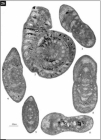Foraminifera taxon details
Neomillerella Gaillot & Vachard, 2007 †
1052744 (urn:lsid:marinespecies.org:taxname:1052744)
accepted
Genus
Neomillerella mirabilis Gaillot & Vachard, 2007 † (type by original designation)
- Species Neomillerella gigantea (Kanmera, 1952) †
- Species Neomillerella hataii (Suyari, 1962) †
- Species Neomillerella japonica (Kanmera, 1952) †
- Species Neomillerella kotakiensis (Suyari, 1962) †
- Species Neomillerella mirabilis Gaillot & Vachard, 2007 †
- Species Neomillerella nevadaensis (Douglass & Nestell, 1974) †
- Species Neomillerella tosaensis (Suyari, 1962) †
- Species Neomillerella yowarensis (Ota, 1971) † accepted as Eostaffella yowarensis (Ota, 1971) † (unaccepted > superseded combination, Opinion of Kobayashi and Vachard (2022))
marine, brackish, fresh, terrestrial
fossil only
feminine
Gaillot, J.; Vachard, D. (2007). The Khuff Formation (Middle East) and time-equivalents in Turkey and South China: biostratigraphy from Capitanian to Changhsingian times (Permian), new foraminiferal taxa, and palaeogeographical implications. <em>Coloquios de Paleontologia.</em> 57: 37-223., available online at https://hal.archives-ouvertes.fr/hal-00310245
page(s): p. 48 [details] Available for editors [request]
[request]
page(s): p. 48 [details] Available for editors
Original description Diagnosis: Test relatively large, planispiral and lenticular. Broadly rounded periphery. Lateral sides flattened to...
Original description Diagnosis: Test relatively large, planispiral and lenticular. Broadly rounded periphery. Lateral sides flattened to biumbilicate. Rounded to slightly keeled periphery. Axis of coiling planispiral or weakly deviated. Terminal stage evolute or uncoiled (such as Rectomillerella), generally high. Wall thin, dark, microgranular, differentiated into clearer and darker zones (nevertheless without similarity of the tectum, tectoria, diaphanotheca or luminotheca of other genera of Fusulinida).
Occurrence: Late Carboniferous-Early Permian in Japan. Early Permian of Nevada (USA). The genus probably migrated from Japan after the Early Permian. Lopingian of Zagros, Fars and Abu Dhabi.
(Gaillot and Vachad (2007)). [details]
Occurrence: Late Carboniferous-Early Permian in Japan. Early Permian of Nevada (USA). The genus probably migrated from Japan after the Early Permian. Lopingian of Zagros, Fars and Abu Dhabi.
(Gaillot and Vachad (2007)). [details]
Hayward, B.W.; Le Coze, F.; Vachard, D.; Gross, O. (2025). World Foraminifera Database. Neomillerella Gaillot & Vachard, 2007 †. Accessed at: https://marinespecies.org/Foraminifera/aphia.php?p=taxdetails&id=1052744 on 2025-09-16
Date
action
by
original description
Gaillot, J.; Vachard, D. (2007). The Khuff Formation (Middle East) and time-equivalents in Turkey and South China: biostratigraphy from Capitanian to Changhsingian times (Permian), new foraminiferal taxa, and palaeogeographical implications. <em>Coloquios de Paleontologia.</em> 57: 37-223., available online at https://hal.archives-ouvertes.fr/hal-00310245
page(s): p. 48 [details] Available for editors [request]
[request]
page(s): p. 48 [details] Available for editors
From editor or global species database
Original description Diagnosis: Test relatively large, planispiral and lenticular. Broadly rounded periphery. Lateral sides flattened to biumbilicate. Rounded to slightly keeled periphery. Axis of coiling planispiral or weakly deviated. Terminal stage evolute or uncoiled (such as Rectomillerella), generally high. Wall thin, dark, microgranular, differentiated into clearer and darker zones (nevertheless without similarity of the tectum, tectoria, diaphanotheca or luminotheca of other genera of Fusulinida).Occurrence: Late Carboniferous-Early Permian in Japan. Early Permian of Nevada (USA). The genus probably migrated from Japan after the Early Permian. Lopingian of Zagros, Fars and Abu Dhabi.
(Gaillot and Vachad (2007)). [details]
